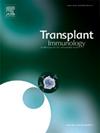一种凝集素亲和血浆置换装置可在对丢弃的供肾进行可控氧合再温后,从肾灌注液中去除细胞外囊泡和microrna。
IF 1.6
4区 医学
Q4 IMMUNOLOGY
引用次数: 0
摘要
肾移植被认为是终末期肾病患者的基准治疗方法,但合适肾脏的稀缺对患者和医疗保健提供者构成了重大障碍。一种方法是扩大使用脑死亡和循环死亡供体肾脏的标准。使用这些器官,特别是来自这些扩展标准供体的器官,与缺血再灌注损伤和由此导致的移植物功能延迟以及同种异体移植物排斥反应率增加有关。为了减少这些并发症并增加器官活力评估的时间,我们对恢复肾脏进行了机器灌注评估。在这项研究中,我们检测了经过控制氧合复温(COR)的废弃器官的灌注液的免疫原性分子含量。分析灌注液的细胞外囊泡(EVs)、DNA(脱氧核糖核酸)和microrna。然后将这些灌注液泵过含有凝集素亲和树脂的等离子体分离器。治疗后,观察到细胞外囊泡、与ev相关的双链DNA (dsDNA)和microrna (miRNA)显著减少。具体来说,在分析的四种肾灌注液中,有三种的小ev (本文章由计算机程序翻译,如有差异,请以英文原文为准。
A lectin affinity plasmapheresis device removes extracellular vesicles and microRNAs from renal perfusates following controlled oxygenated rewarming of discarded donor kidneys
Kidney transplantation is considered the benchmark treatment for end-stage kidney disease patients, yet the scarcity of suitable kidneys poses a significant hindrance for patients and healthcare providers. One approach is to extend the criteria for the use of kidneys from deceased brain death and deceased circulatory death donors. Use of these organs, especially from these extended criteria donors, is associated with ischemia reperfusion injury and resultant delayed graft function as well as increased rates of allograft rejection. To lessen these complications as well as increase the time of organ viability assessment, machine perfusion has been evaluated on recovered kidneys. In this study we examined the immunogenic molecular content of perfusates from discarded organs that had undergone Controlled Oxygenated Rewarming (COR). Perfusates were analyzed for extracellular vesicles (EVs), DNA (Deoxyribonucleic acid), and microRNAs. These perfusates were then pumped over a plasma separator containing a lectin affinity resin. Following treatment, a significant diminution in extracellular vesicles, dsDNA (double-stranded DNA) associated with EVs, and microRNAs (miRNA) were observed. Specifically, in three out of the four renal perfusates analyzed there was significant removal of small EVs (<200 nm) and vesicles loaded with dsDNA (p < 0.05). Notably, depletion of larger EVs (100-500 nm) was found to be significant in all treated perfusates (p < 0.01). NanoString analysis of miRNA found 5 species potentially involved in renal dysfunction (hsa-let 7a-5p, hsa-miR-148b-3p, hsa-miR-148a-3p, hsa-miR-29b-3pb and hsa-miR-99a5p) to be significantly depleted in treated renal perfusates (p ≤ 0.05). These results support a future study incorporating this treatment method into a dynamic machine perfusion circuit to explore if reduction of these mediators is associated with improved function of retrieved kidneys.
求助全文
通过发布文献求助,成功后即可免费获取论文全文。
去求助
来源期刊

Transplant immunology
医学-免疫学
CiteScore
2.10
自引率
13.30%
发文量
198
审稿时长
48 days
期刊介绍:
Transplant Immunology will publish up-to-date information on all aspects of the broad field it encompasses. The journal will be directed at (basic) scientists, tissue typers, transplant physicians and surgeons, and research and data on all immunological aspects of organ-, tissue- and (haematopoietic) stem cell transplantation are of potential interest to the readers of Transplant Immunology. Original papers, Review articles and Hypotheses will be considered for publication and submitted manuscripts will be rapidly peer-reviewed and published. They will be judged on the basis of scientific merit, originality, timeliness and quality.
 求助内容:
求助内容: 应助结果提醒方式:
应助结果提醒方式:


